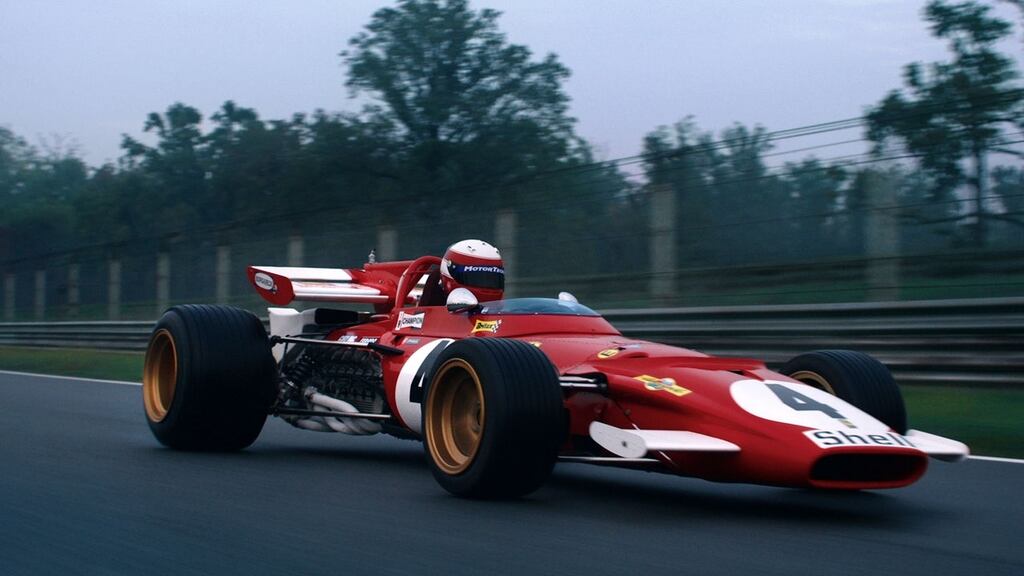Doubtless, there will be some eye rolling amongst those who care not for cars at the arrival of this film in cinemas. To have cars on the big screen is nothing new, whether it's classic movies such as Formula One or Le Mans, or more recent fare such as Senna or Rush, but here the car itself is the title. Ferrari 312B, a collection of letters and numbers that will mean little or nothing to the uninitiated, but everything to the cognoscenti.
Created by Ferrari's then-chief of engineering, Mauro Forghieri, it was aimed to try and reverse Ferrari's late-1960s decline, in the face of competition from Lotus, Brabham, Tyrell, McLaren and the other mostly British-based car makers whom Ferrari himself disparagingly referred to a 'garagistes' - kit-car makers, essentially.
Ferrari, then as now, made the whole car, from the engine to the chassis to the wheels, and so Forghieri, in the days before sprawling engineering teams and cad-cam manufacturing designed the car himself. The whole car. “Born only with the drafting table and the pencil,” as the man himself puts it in his distinctively croaky voice. “Made with the tape measure and the hammer.”
Some 46 years on from the car's 1970 debut season, former F1 racer and Le Mans winner Paolo Barilla is trying to resurrect just one of four 312Bs built in that year, and wants to bring it to the Monaco Historic Grand Prix. And he has Forghieri to help him.
Exquisitely expensive Lego set
It’s an expensive, intensive undertaking - recreating and rebuilding an all-but unique car, starting with the individual components of its 3.0-litre flat-12 engine laid out like the most exquisitely expensive Lego set you’ve ever seen. It is alarmingly complex. Forghieri compares the work done in period to the rockets that NASA was sending to the Moon. Indeed, the flat-12 engine was itself originally designed for use in an aircraft, and it’s not hard to see the comparison to rocketry when you see the 312B’s chassis, stripped back to unpainted aluminium and moodily lit.
The heart of any Ferrari is, of course, its engine and it is the flat-12 that draws the lion’s share of attention both from the film makers and the team trying to get the car ready for Monaco. And it is here that you realise the story is not about the car at all. It is actually a tribute, and a moving one at time, to Forghieri himself.
A difficult man to deal with (as witnessed by an anecdote from a chuckling Niki Lauda) Forghieri is someone who has never quite been given their due by racing history. While Lotus' Colin Chapman is (rightly) lauded as a genius, Forghieri's creation, which began as spidery, almost ghostly pencil sketches, would go on to win four constructors' and three drivers' titles through the seventies, and left a legacy which would be picked up on again by the likes of Michael Schumacher and Ross Brawn in the 2000s. Forghieri was unquestionably a genius, and the differentiated equal of Chapman.
Fulminating at failure
It is wonderful to see him today still prowling the pitlane like a pro, dipping his head into the cockpit and under the chassis to try and make adjustments, to bark orders at the increasingly-careworn Stefano, currently the car’s mechanical keeper.
While Barilla, the man driving the car and bankrolling the operation, remains cheerfully stoic through it all, Forghieri fulminates at failure and you can see the frustration as he constantly has to rmeind himself that he no longer has the resources of Ferrari itself behind his efforts. He is the man of “1,000 ideas and 1,000 solutions” as one person puts it, constantly chivvying away at problems and issues, and at one stage really losing his rag with those charged with rebuilding the mighty engine, or trying to squeeze extra laps out of a testing session to sort an throttle issue. He must have been in equal parts enraging and inspiring to work with.
So is it Forghieri or his 312B that is the star of the show here? Certainly, the car itself is an amazing piece of work, from its blood-scarlet paint work to its ear-splitting shriek, which even now has the power to cause its creator to jump at the noise in close quarters. As Barilla puts it, it’s not about bringing the car back to life to race or win, but to simply show it as it was to people. “The car can be beautiful for anyone who sees it, who feels it, who lives it” he says at Monaco on the day of the historic race. “A Ferrari must express itself, and a car can only express itself at 100 per cent of its possibilities. We must push it to the limit to make it like it once was.”
It is a beautiful thing, in repose or in motion, but for me this is a film about Forghieri. His still-combative nature, his obsession with tiny details, and his clear disappointment when things don't work. The competitive fire still burns white-hot in Forghieri, the man described by his former driver Jacky Ickx as "possibly the best engineer of the era." The best or otherwise, it's clear that like his creation, Forghieri still belongs at the race track.











